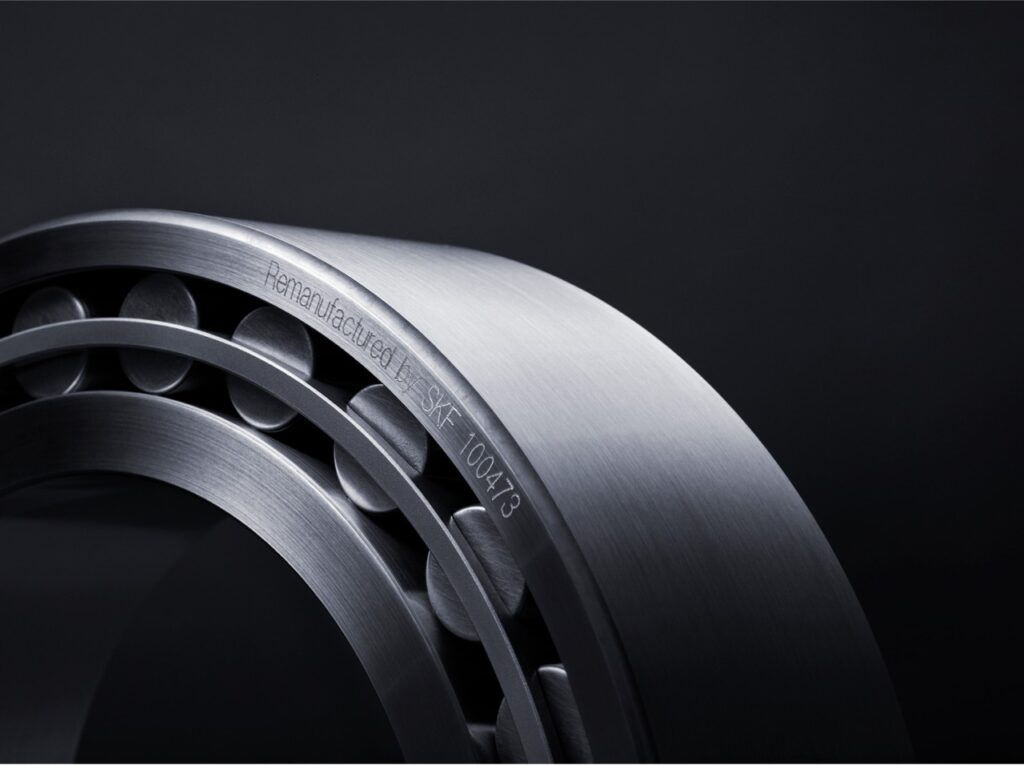SKF has established itself as the home of remanufactured bearings, delivering cost savings, efficiency improvements, and fast turnaround times. These advantages make it a preferable alternative to purchasing brand-new bearings for a diverse range of customers.
SKF head of engineering services Pieter Blackie recently provided an overview of this service, but this article will explain the required steps in-detail and how SKF assures the quality of its remanufacturing services.
Remanufacturing is the process of removing bearings from service when the opportunity presents. This often occurs simultaneously with other planned or unplanned maintenance activities, so that any developing surface damage can be corrected before it progresses to a point of no return.
The required steps include disassembly and cleaning, before polishing or grinding the critical surfaces back into original specifications. This can often give the bearing years of added service and saves owners the time and money spent sourcing a new replacement.
One reason new bearings can cost more time and money is that their manufacturing process requires many more resources – from sourcing raw materials to machining, heat treatment, packaging, and transportation.
In contrast, remanufacturing requires far fewer resources, as the material is reused and no new heat treatment is needed, creating significant energy savings.
The steps required for remanufacturing are as follows: SKF receives the used bearing; performs pre-inspection and external checks; disassembles it; cleans it of contaminants; does a detailed inspection of damage; selects the correct remanufacture method; provides polishing or grinding; reassembles the bearing; does an extensive quality check; then packages it and delivers back to the client.
This process is typically completed in less than four weeks and can be faster depending on a customer’s requirements.
One of the best parts about remanufacturing is that it can be applied to several types of rolling bearings, for example large spherical roller bearings, large CARB bearings, bearing units for railways, housings, slewing bearings, and special bearing units.
Of course, it’s always best if the given bearing is under a predictive maintenance schedule to ensure it is dismounted and remanufactured at the correct time.
If remanufacturing is well-timed, a bearing can be restored two to three times (depending on the application and operating conditions), avoiding the inconvenience of long lead times on new bearings.

Who’s taking advantage?
SKF has seen customers from a wide range of industries benefit from bearing remanufacturing, including mining, steelworks, paper, traditional power, wind, and cement.
In 2023, a coal fired power station extended its operational lifespan and operators found they needed to replace a large spherical roller thrust bearing on a critical pump. But the bearing in storage was in poor condition so a quick response was required.
SKF application engineer George Zeman said it was an exciting challenge to turnaround these vital bearings in one weekend.
“The team was proud to devote some overtime to this important piece of infrastructure,” he said.
“In just 48 hours, the bearing was remanufactured and given years of extra life so that the coal fired power station could continue powering the state. The alternative of buying a new bearing was far too costly and slow for the customer to manage, so we basically saved the day.”
In a separate case study, another customer approached SKF with an urgent need to replace two crucial 241/750 ECAK30/CNPW33 spherical roller bearings used in a high-pressure grinding roller. The lead time on new bearings was six months, so SKF stepped up with a better solution.
It took two SKF technicians 120 working hours over just five days to meticulously inspect and remanufacture both bearings. This saved the customer a total of $127,600 – the difference between new and remanufactured bearings in this case – not to mention the time saved on delivery.

Quality assurance
One might assume that such a tight turnaround could forfeit some of the quality of new bearings, but SKF ensures this isn’t the case.
To provide full traceability, SKF uniquely marks each asset during the remanufacturing process. This means customers can trace their bearing through its future life cycle and trust that the process has been thorough.
SKF then generates a certificate to document a customer’s avoidance of carbon emissions. Its calculations are based on the avoided energy use in SKF’s and suppliers’ production phases when using reconditioned bearings instead of buying new ones.
In fact, since SKF began remanufacturing bearings, it has avoided the production of over 2500 tonnes of carbon emissions. This is equivalent to 600 tonnes of steel and 5.5 million kWh of energy.
To reap the rewards of SKF bearing manufacturing, visit the website.




